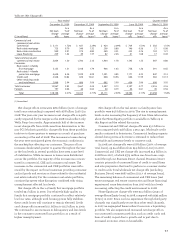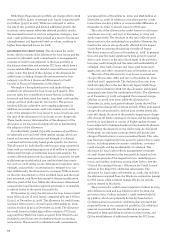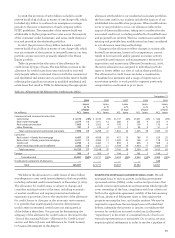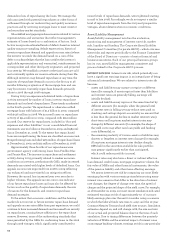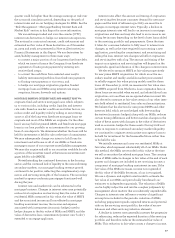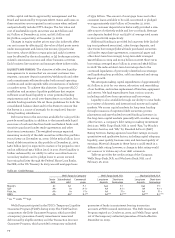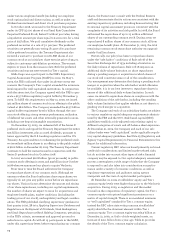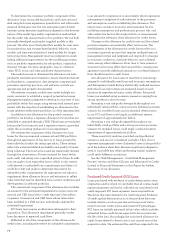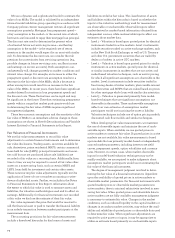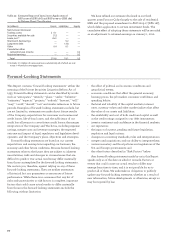Wells Fargo 2009 Annual Report Download - page 73
Download and view the complete annual report
Please find page 73 of the 2009 Wells Fargo annual report below. You can navigate through the pages in the report by either clicking on the pages listed below, or by using the keyword search tool below to find specific information within the annual report.
Parent. Under SEC rules, the Parent is classified as a “well-
known seasoned issuer,” which allows it to file a registration
statement that does not have a limit on issuance capacity.
“Well-known seasoned issuers” generally include those
companies with a public float of common equity of at least
$700 million or those companies that have issued at least
$1 billion in aggregate principal amount of non-convertible
securities, other than common equity, in the last three years.
In June 2009, the Parent filed a registration statement with the
SEC for the issuance of senior and subordinated notes, preferred
stock and other securities. This registration statement replaces
a registration statement for the issuance of similar securities
that expired in June 2009. The Parent’s ability to issue debt
and other securities under this registration statement is
limited by the debt issuance authority granted by the Board.
The Parent is currently authorized by the Board to issue
$60 billion in outstanding short-term debt and $170 billion
in outstanding long-term debt.
At December 31, 2009, the Parent had outstanding
short-term and long-term debt under these authorities of
$10.2 billion and $119.5 billion, respectively. During 2009, the
Parent issued a total of $3.5 billion in registered senior notes
guaranteed by the FDIC under the TLGP and an additional
$2.0 billion in non-guaranteed registered senior notes. Effective
August 2009, the Parent established an SEC registered $25 billion
medium-term note program (MTN), under which it may issue
senior and subordinated debt securities. In December 2009,
the Parent established a $25 billion European medium-term
note programme (EMTN), under which it may issue senior
and subordinated debt securities. In addition, the Parent has
an A$5.0 billion Australian medium-term note programme
(AMTN), under which it may issue senior and subordinated
debt securities. The EMTN and AMTN securities are not
registered with the SEC and may not be offered in the
United States without applicable exemptions from registration.
The Parent has $23.0 billion, $25.0 billion and A$1.75 billion
available for issuance under the MTN, EMTN and AMTN,
respectively. The proceeds from securities issued in 2009
were used for general corporate purposes, and we expect that
the proceeds from securities issued in the future will also be
used for general corporate purposes. The Parent also issues
commercial paper from time to time, subject to its short-term
debt limit.
Wells Fargo Bank, N.A. Wells Fargo Bank, N.A. is authorized
by its board of directors to issue $100 billion in outstanding
short-term debt and $50 billion in outstanding long-term
debt. In December 2007, Wells Fargo Bank, N.A. established a
$100 billion bank note program under which, subject to any
other debt outstanding under the limits described above, it
may issue $50 billion in outstanding short-term senior notes
and $50 billion in long-term senior or subordinated notes.
During 2009, Wells Fargo Bank, N.A. issued $14.5 billion in
short-term notes. At December 31, 2009, Wells Fargo Bank, N.A.
had remaining issuance capacity on the bank note program
of $50 billion in short-term senior notes and $50 billion in
long-term senior or subordinated notes. Securities are issued
under this program as private placements in accordance with
Office of the Comptroller of the Currency (OCC) regulations.
Wells Fargo Financial. In February 2008, Wells Fargo
Financial Canada Corporation (WFFCC), an indirect wholly-
owned Canadian subsidiary of the Parent, qualified with the
Canadian provincial securities commissions CAD$7.0 billion in
medium-term notes for distribution from time to time in Canada.
At December 31, 2009, CAD$5.5 billion remained available for
future issuance. In January 2010, WFFCC filed a new short
form base shelf prospectus, replacing the February 2008 base
shelf prospectus and qualifying a total of CAD$7.0 billion of
issuance authority. All medium-term notes issued by WFFCC
are unconditionally guaranteed by the Parent.
FEDERAL HOME LOAN BANK MEMBERSHIP We are a member
of the Federal Home Loan Banks based in Atlanta, Dallas,
Des Moines and San Francisco (collectively, the FHLBs). Each
member of each of the FHLBs is required to maintain a mini-
mum investment in capital stock of the applicable FHLB. The
board of directors of each FHLB can increase the minimum
investment requirements in the event it has concluded that
additional capital is required to allow it to meet its own regu-
latory capital requirements. Any increase in the minimum
investment requirements outside of specified ranges requires
the approval of the Federal Housing Finance Board. Because
the extent of any obligation to increase our investment in
any of the FHLBs depends entirely upon the occurrence of
a future event, potential future payments to the FHLBs are
not determinable.
We have an active program for managing stockholders’ equity
and regulatory capital and we maintain a comprehensive
process for assessing the Company’s overall capital adequacy.
We generate capital internally primarily through the retention
of earnings net of dividends, and through the issuance of common
stock to certain benefit plans. Our objective is to maintain
capital levels at the Company and its bank subsidiaries above
the regulatory “well-capitalized” thresholds by an amount
commensurate with our risk profile. Our potential sources of
stockholders’ equity include retained earnings and issuances
of common and preferred stock. Retained earnings increased
$5.0 billion from December 31, 2008, predominantly from
Wells Fargo net income of $12.3 billion, less common and
preferred dividends and accretion of $6.4 billion. On March 6,
2009, the Board reduced the common stock dividend to $0.05
to retain current period earnings and build common equity.
During 2009, we issued approximately 958 million shares,
with net proceeds of $22.0 billion of common stock, including
882 million shares ($20.5 billion) in two common stock offerings
and 76 million shares from time to time during the period
Capital Management




